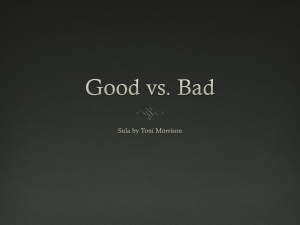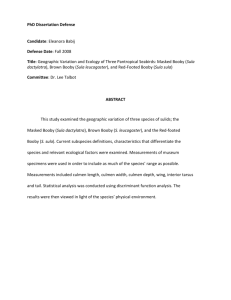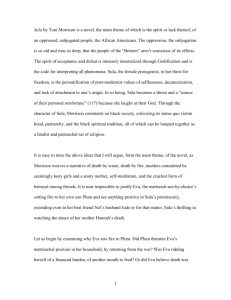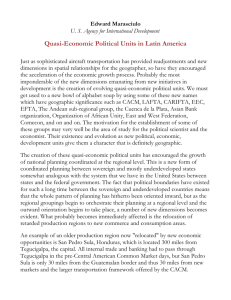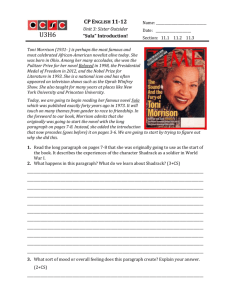Sula. A Rule
advertisement
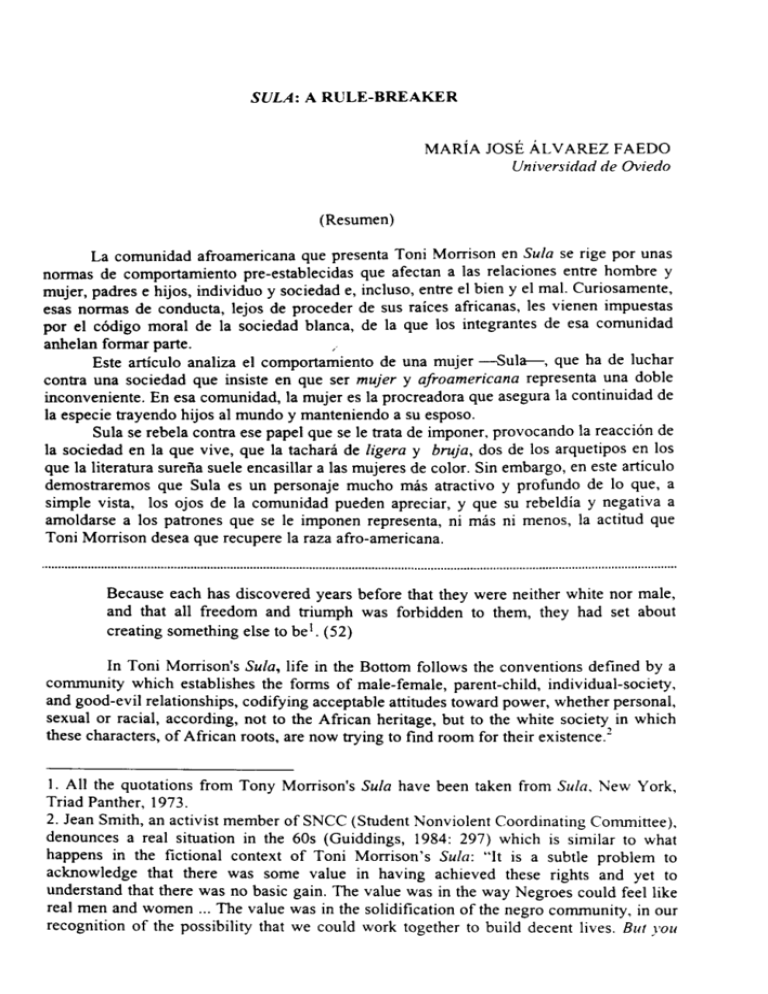
SULA: A RULE-BREAKER MARÍA JOSÉ ALVAREZ FAEDO Universidad de Oviedo (Resumen) La comunidad afroamericana que presenta Toni Morrison en Sula se rige por unas normas de comportamiento pre-establecidas que afectan a las relaciones entre hombre y mujer, padres e hijos, individuo y sociedad e, incluso, entre el bien y el mal. Curiosamente, esas normas de conducta, lejos de proceder de sus raíces africanas, les vienen impuestas por el código moral de la sociedad blanca, de la que los integrantes de esa comunidad anhelan formar parte. Este artículo analiza el comportamiento de una mujer —Sula—, que ha de luchar contra una sociedad que insiste en que ser mujer y afroamericana representa una doble inconveniente. En esa comunidad, la mujer es la procreadora que asegura la continuidad de la especie trayendo hijos al mundo y manteniendo a su esposo. Sula se rebela contra ese papel que se le trata de imponer, provocando la reacción de la sociedad en la que vive, que la tachará de ligera y bruja, dos de los arquetipos en los que la literatura sureña suele encasillar a las mujeres de color. Sin embargo, en este articulo demostraremos que Sula es un personaje mucho más atractivo y profundo de lo que, a simple vista, los ojos de la comunidad pueden apreciar, y que su rebeldía y negativa a amoldarse a los patrones que se le imponen representa, ni más ni menos, la actitud que Toni Morrison desea que recupere la raza afro-americana. Because each has discovered years before that they were neither white ñor male, and that all freedom and triumph was forbidden to them, they had set about creating something else to be'. (52) In Toni Morrison's Sula, life in the Bottom follows the conventions defined by a community which establishes the forms of male-female, parent-child, individual-society, and good-evil relationships, codifying acceptable attitudes toward power, whether personal, sexual or racial, according, not to the African heritage, but to the white society in which these characters, of African roots, are now trying to find room for their existence." 1. All the quotations from Tony Morrison's Sula have been taken from Sula, New York, Triad Panther, 1973. 2. Jean Smith, an activist member of SNCC (Student Nonviolent Coordinating Committee), denounces a real situation in the 60s (Guiddings, 1984: 297) which is similar to what happens in the fictional context of Toni Morrison's Sula: "It is a subtle problem to acknowledge that there was some valué in having achieved these rights and yet to understand that there was no basic gain. The valué was in the way Negroes could feel like real men and women ... The valué was in the solidification of the negro community, in our recognition of the possibility that we could work together to build decent Uves. Bul you 70 M" José Álvarez-Faedo This article studies the ways in which a woman, Sula, behaves in a community which confronts her with the double handicap of being a black woman\ According to that community, the distinguishing characteristics of women are that they are life-makers, ensuring the continuity of the community by bearing children" and by supporting their men sexually, emotionally, or fmancially. That is a role Sula rebels against, bringing along the reaction of that community, which sees her as an evil creature -who challenges the authority of her elders-- and classifies her into female archetypes: the loóse woman and the witch. But, as we shall see in the next pages, this character is far more attractive and her reality far more complex and deeper than what the community's eyes can appreciate. The treatment and attitude towards Sula most overtly reveal the pattems of the community. By ignoring or deliberately violating the conventions established by the community, she threatens the assumptions by which life in the Bottom is organized and made meaningful, and thus she becomes the embodiment of evil. By naming her evil, they seek to bring her within the framework of their world view, but, as we shall see, this effort is itself inherently ambiguous. Morrison establishes early the events that make Sula's musí see that there was no basic change. I personally resisted this for a long time. I had invested so much ofmyselfin the fight that I didn 't want to admit that it carne to so little. (My italics.)" 3. It is worth pointing out that the feminist movement of the 60s was a tuming point for white women but, as regards black women, its effects were less relevant than those of the Civil Rights Movement. The racist and discriminating attitude of most feminist organizations at the time prevented black women from adhering to them. Moreover, the goals middle-class white women wanted to reach differed from those which interested African-American women -being, most of them, lower-class women. That is why it will not be until the 70s that the feminist movement gains strength among the latter. Angels Carrabí (1988; 25) explains that: "Desde el punto de vista literario, la década de los 70 se caracterizó para la cultura negra por un repentino fluir de obras cuyas autoras eran mayoritariamente mujeres." And she adds: "La mujer, tradicionalmente ausente o relegada a un segundo plano en la tradición literaria, pasó a ser protagonista de la escena. Las obras de escritoras como Maya Angelou, [...] Toni Morrison, Alice Walker, y otras muchas, abordaron los problemas que afectaban a la mujer como individuo y como ser social." 4. Angels Carrabí (1988: 47) also deals with this approach to African-American women us "life makers": "Si bien es cierto que la función reproductora de la mujer africana continuó siendo el motivo principal de su presencia en el nuevo continente, el carácter casi sagrado de su papel social fue desvalorizado. En las poblaciones de las costas occidentales de África, el cuidado de la descendencia era fundamental para asegurar la continuidad de la tribu. Con este fin, la mujer embarazada solía abandonar el habitáculo de su esposo antes de dar a luz y retomaba al hogar paterno. Allí permanecía por un periodo de unos tres años hasta que sus cuidados aseguraban la salud del nuevo miembro de la tribu. Una vez finalizado este primer periodo, la mujer regresaba al hogar del esposo encontrándose dispuesta para poder llevar a cabo otro embarazo. En el nuevo continente, este meticuloso proceso ennoblecedor del papel materno, se convirtió en una cruel ironía. Considerada por su naturaleza de esclava como propiedad y no como ser humano, su función de continuadora de la especie perdió ese carácter sagrado. De su condición de medio-diosa, pasó a ser una máquina generadora de esclavos que engrosaban, con un gasto mínimo, las fílas de trabajadores." Sula: a Rule-breaker 71 identity an essentially negative one. And it is true that, at one level, she appears to be the villainess of the novel. Sula is "distinctly different" (107), her goal in life is not that on an average woman, and her society promptly calis her a "devil" (106). Consequently "she was pariah, then, and knew it" (110). The conflict between individual and society is established from the beginning, by confronting two opposing characters who represent two different ways of life. Grandmother Eva -who stands for survival in the novel—and Sula who, by affirming her identity in a community which has bcen taught to escape from any sign of it, makes the first move to break the chain of continuity. Her second move is to annihilate the authority of those who are the keepers of the valúes of that society: the oíd people in the tribe. In a ferocious argument, Eva and Sula confront history and revolution: "It ain't right for you to want to stay off by yourself. You need ... I'm a tell you what you need." Sula sat up, "I need you to shut your mouth." (85) Furious and deeply offended by her granddaughter's lack of respcct, Eva resorts to religión in order to reaffírm her authority: "Bible say honour thy father and thy mother that thy days may be long upon the land thy God giveth thee" (86). Sula shows, sarcastically, her indifference towards Christian commandments and she uses the same arguments against Eva to suggest the hypocrisy which hides in religión: "Mamma must have skipped that part. Her days wasn't too long." "Pus mouth! God's going to strike you!" "Which God: The one watched you bum Plum?" (86) The Christian echoes of Eva's upbringing go back to her origins: being the bearer, in her own ñame, of the myth of the siimer expelled from the garden of Edén, she threatens Sula with the damnation of the fallen man: "Pride goeth before a fall" (86). Once more, Sula's reply summarizes her independent, challenging and liberal attitudc, frec from any ethical or Christian constraint: "What the hell do I care about falling?"' (86). The coexistence of these two ideologies is impossible. Sula's youth and determination triumph over Eva's lesser physical and moral strength. The challenge translatcs into a fire symbology which, ironically tums against Eva. As Eva had used redeeming fire to sacrifíce her own son Plum on behalf of the African-American race, Sula threatens Eva with buming her alive: "And you know what: maybe one night when you dozing in that wagón flicking flies and swallowing spit, maybe I'11 just tip on up here with some kerosene and --who knows—you may make the brightest flame of them all" (87). That image of the dirty "flies" over Eva represents not only her personal decadence, but also that of the valúes she stands for: from generating life in survival times to bearing spiritual death. Thus, Toni Morrison describes the end of Eva's hegemony and, with it, the fall of the house called, ironically, Peace -a soothing "peace" which ends up destroying. By secluding her grandmother in an old-people's home, Sula challenges history*: "So Eva locked the door from then on. But it did no good. In April two men came with a stretchcr and she didn't even have time to comb her hair before they strapped her to a piece of canvas. ( 87)" 5. "Sula was not afraid of 'the free fall' ... (It's a phrase which has a possible echo of Milton's Lucifer.) The conventional womcn of the Bottom were" (Mickelson, 1979: 316). 6. Toni Morrison, in an interview (Stepto, 1977: 478), said: "And also, Sula did the one terrible thing for black people which was to put her grandmother in an oíd folks' home, which was outrageous, you know. You take care of people! So that would be her terrible thing." 72 M" José Álvarez-Faedo For any community in the year 1937, Sula's decisión to get rid of her grandmother would be unaccepuble and severely objected to. For the African-American community which, from its earliest times has professed special respect and devotion to the ciders -not only when ahve, but also after they had died--, Sula's rule-breaking attitude has gene too far and she cannot be forgiven: "When the word got out about Eva being put in Simnydale, the people in the Bottom shook their heads and said Sula was a roach" (95). From a moral perspective, she is rejected because of the ease with which she sleeps with men, casually discarding them immediately after an affair. From a very early age, her fantasies defined her as a rider and a taster of confections, predetemnining her later attitude towards men: "Sula ... spent hours in the attic behind a roll of linoleum galloping through her own mind on a grey-and-white horse tasting sugar and smelling roses in fiíll view of someone who shared both the taste and the speed" (52). Her friend Nel recriminates her: "You can't do it all. You a woman and a coloured woman at that. You can't act like a man. You can't be walking around all independent-like, doing whatever you like, taking what you want, leaving what you don't" (127). The difference between both women is settled in this statement: Nel is bound to her condition of "woman and a coloured woman", whereas Sula rebels against it, she is "all independent", and, consequently, she can "act like a man". And her sexual incontinence' is even more horrifying due to her supposedly having slept with white men, an act cióse to a taboo in this closed society. Her grandmother's evidence that Sula watched her mother bum to death "because she was ínterested" (74), also militates against her. She is vilified and referred to as witch^: "so they laid broomsticks across their doors at night and sprinkled salt on porch steps" (103). To add to her misfortunes, she witnesses the fragile boy Teapot fracture his bones in a fall, and she is suspected of having pushed him down: "When Sula said no, the boy tumed round and fell down the steps. He couldn't get up right away and Sula went to help him. His mother ... saw Sula bending over he son's pained face. She flew into a fit of 7. A type of black woman that becomes a literary stereotype is the loóse woman., described by Barbara Christian (15): "she is brown skinned, rather than black, and voluptuous, rather than fat, and she possesses a sensuous mouth and a high behind." And she adds that she is also characterized by a perverse nature: "She is known to have an "evil" disposition, a characteristic that constitutes rather than distracts from her sexiness, which is contrasted with the sweet demeanor of the lady. She is good looking and passionate, but never beautiñil, for her animal nature rather than her human qualities are foremost in her makeup. She ensnares men with her body rather than uplifting them with her beauty." 8. Another image of the black woman was that of conjure woman, the witch. The same as the "loóse woman", the witch represented the dark side of human existence. If the former was the scape-goat of sexual repression, the latter was in contact with the supematural world, a world which was forbidden and, at the same time, feared by the followers of the Christian faith: "Much of the early southem literature argües that slavery was really a blessing for the Afhcans since it separated them from the dark effects of heathenism and introduced them to the saving light of Christianity. In this context, it was necessary continually to keep alive the image of African heathenism, so the slave master could use slavery as part of an overall Christian crusade to elévate otherwise damned souls to possible levéis of salvation." (Christian, 16) Sula: a Rule-breaker 73 concemed, if drunken, motherhood, and dragged Teapot home. She told everybody that Sula had pushed him ... (103)" Furthermore, she is believed to be the remote cause for an oíd man's choking on a bone: "Mr. Finley sat on his porch sucking chicken bones, as he had done for thirteen years, looked up, saw Sula, choked on a bone and died on the spot" (104), which, added to the unfortunate and unplanned circumstances surrounding Chicken Little's death at the hands of Sula: "Sula picked him up by his hands and swung him outward then around and around. ... When he slipped from her hands and sailed away out over the water they could still hear his bubbly laughter" (60). Sula's evií quality is reinforced by the presence of the robins which, as a plague, accompany her during her retum to Medallion. She is the scapegoat, the remote cause of the townspeople's misfortunes in a society which has to face the unemployment arising out of unfulfilled promises and the poignant poverty and malnutrition, disease and ignorance, a society which chooses superstition as their only way out. Consequently, nothing short of Sula's death can relieve them of their plight, but they are a patient people ready to wait for the glorious event, rather than take action against her: "They would no more run Sula out of town than they would kill the robins that brought her back. ... There was no creature so ungodly as to make them destroy it" (107). But Sula is not an evil villainess. The author develops this character in a complex manner so that, after a time, the reader comes to realize that she is not simply the perpetrator of evil that her society supposes her to be, but an insecure woman, whose neurosis stems from her unstable relationship with her mother, rooted in her mother's denial of her daughter: "... You love her, like I love Sula. I just don't like her. That's the difference." ... She only heard Hannah's words, and the pronouncement sent her flying up the stairs. In bewilderment, she stood at the window fmgering the curtain edge, aware of a sting in her eye". (57) Sula cannot maintain any affectionate bonding with a mother who admits to not liking her daughter, but to seeing her (quite justifiably in the male-bereft economies of the Bottom) as a burden and a cross to bear. Henee, a rejected Sula watches her mother bum to death without so much stirring a muscle. This episode, along with Sula's being, by chance, the instrument who effected Chicken Little's death, are crucial events in Sula's life. "The first experience taught her there was no other that you could count on, the second that there was no self to count on either. She had no centre, no speak around which to grow" (107-08). The fact that she possesses no "ego" (108) accounts for her inconsistency. The only thing she was sure about, was her wish to be different from what she was, a black woman. Enjoying the freedom and joys of being a white male was something she had yeamed from her early childhood: "Because each had discovered years before that they were neither white ñor male, and that all freedom and triumph was forbidden to them, they had set about creating something else to be" (52). And it is this intense life-grabbing insistence on freedom that is eventually interpreted as recklessness, tuming Sula into a threat, as her life unfolds against the rest of the black community's daily life of hardship, humiliation and fight for survival. Par from being an evil influence, Sula can be considered a catalyst for good in the society -a society made of people whom she has helped to recover their sense of community, driving them closer to each other: 74 M" José Álvarez-Faedo Their conviction of Sula's evil changed them in accountable yet mysterious ways. Once the source of their personal misfortune was identified, they had leave to protect and love one another. They began to cherish their husbands and wives, protect their children, repair their homes and, in general, band together against the devil in their midst. (106-07) She revitalizes Medallion through a sexual revolution moved by an unconscious desire to make the town a better place, since to her: "Half this town need ... killing and the other half... a drawn-out disease" (89). As long as she is alive, she gives a meaning to these disgruntled people's existence, since her presence motivates a holier-than-thou attitude in her antagonists and unites them against her. Abused by the populace unfortunate comments, Sula deserves our sympathy. Morrison dramatizes the ironical bent in the portrayal of Sula in the character's attitude toward sexual positions: "... there was utmost irony and outrage in lying under someone, in a position of surrender, feeling her own abiding strength and limitless power" (111). But her rejection of matemity means an assumption of male freedom, as it is suggested in a conversation with Eva: "... When are you going to get married? You need to have some babies. It'll settle you." "I don't want to make somebody else. I want to make myself (85). And in her last encounter with Nel: "You say I'm a woman and coloured. Ain't that the same as being a man." "I don't think so and you wouldn't either if you had children." "Then I really would act like what you cali a man. Every man I ever knew left his children." (128) Although Sula is, in many respects, a product of her community, she is bated for being different', nevertheless, though often maligned, she has a hidden dimensión. As she puts it to Nel: "How do you know ... About who was good? ... I mean maybe it wasn't you. Maybe it was me." (131) Sula, who at the age of eleven cut off the tip of her finger to demónstrate to a gang of threatening boys what she could do to them if she could do that to herself, when she grows up, goes to the big city, gets herself an education, and retums a "liberated" woman with a strange mixture of cynicism and irmocence. She explored her own thoughts and emotions, feeling no obligation to picase anybody unless their pleasure pleased her, that is, leading a life always ready to new experiences.'" 9. "Su criterio individual que a lo largo de sus diez años de experiencia fuera del Bottom se ha ido sedimentando, se contrapone a los patrones de conducta establecidos por los habitantes del Bottom y entran en conflicto." (Carabí, 1988: 123). 10. Alice Walker, in In Search ofOur Mother's Gardens (1983: 121-122), also reflects on the experiencc of, in her own words, being "callad to life": "If knowledge of my condition is all the freedom I get from a "freedom movement", it is better than unawareness, forgottenness and hopelessness,'the existence that is like the existence of a beast. Man only truly lives by knowing; otherwise, he simply performs, copying the daily habits of others, but conceiving nothing of his creative possibilities as a man and accepting someone else's superiority and his own misery ... In the white world I walked less real to them than a shadow; and being young and well hidden among the slums, among people who also did not exist - either in books or in films or in the govemment of their own lives -1 waited to be called to life. And, by a miracle, I was called." Sula: a Rule-breaker 75 Sula emerges as a sinister forcé, sex-hungry, man-stealing, death-dealing, a figure of darkness and betrayal. The freedom that she achieves is as much a prison as it is liberation. Totally free, she becomes obsessed with herself, unable to love, uncontained by the normal rules and boundaries we have come to associate with human beings. Having dared to smash the taboos that are her neighbours' poor guarantees of simply surviving, she is scomed, despised, abandoned by the people she grew out of - to their immense loss. For all her selfishness and cruelty, Sula's presence elicits the best in people, diluting their usual meanness and small-spiritedness. According to Houston A. Baker (251): "Sula in the role of a male Pygmalion's deconstructor, rather than a female statue in passive transformation, goes through layers and layers of suppression in order to arrive at the soil of community" and he concludes: "Her swallowing is beneficently anthropophagic." Indeed, with Sula's death" the "Bottom" dies, its black people rushing heedlessly in a comi-tragedy of communal suicide. Nevertheless, Sula "doesn't stop existing even after she dies"—Toni Morrison (Parker, 1979: 254) reveáis. And she adds: "In fact, what she left behind is more powerful after she is dead than when she was alive." The novelist explains in another interview what she really tried to reflect in Sula: ... a rule-breaker, a kind of law breaker, a lawless woman ... Sula does not ... believe in any of those laws and breaks them all. Or ignores them. So that she becomes more interesting ... because of that quality of abandon.... Sula ... knows all there is to know about herself because she examines herself, she is experimental with herself, she's perfectly willing to think the unthinkable thing and so on. But she has trouble making a connection with other people and just feeling that lovely sense of accomplishment of being cióse in a very strong way. (Stepto, 476-77) Worried about the present and, specially, about the future of the African-American race, Toni Morrison, in Sula, denounces that the excessive acceptance of African-American people has brought their evolution process to a halt and, as a consequence, it has reduced the possibilities of the individuáis who are part of it, specially those of African-American women. Those individuáis who have dared to challenge the established pattems have been discouraged -or. if persisting, destroyed—on behalf of the survival of the community. Tony Morrison is not offering conciliating solutions, but encouraging a rebelling, rule-breaking attitude: "A través de Sula, la novelista lleva a sus extremos el comportamiento revolucionario de una mujer que combate con su actitud los cánones establecidos" (Carabí, 123). According to her, the first step African-Americans must take if they worry about the future is to question their community valúes, and then change and update them. 11. "Unfortunately, the literary destiny of most rebel women - death - does not spare Sula. ... She dies at thirty, but not without stating that her rebellion has been the natural outcome of her dialectic" (Mickelson, 316). The critic offers a philosophical explanation for Sula's rebellious and rule-breaking existence: "On her death bed, she sustains her position philosophically by weighing the pros and cons of what is good and bad, renounces the accepted definition of goodness, and reiterates her belief that it is only life that matters." And she concludes: "Life is important, life must be lived and duty and suffering on this earth are too high a price to pay for heavenly immortality." 76 M" José Álvarez-Faedo REFERENCES Baker, H. A. Jr. (1993): "When Lindbergh Sleeps with Bessie Smith: The Writing of Place in Sula'. In Gates, H. L. Jr & Appiah, K.A. (1993): Tony Morrison (Critical Perspectives Past and Present). New York: Amistad Press Inc.: 236-60. Carrabí, A. (1988): Toni Morrison: Búsqueda de una identidad afroamericana. Barcelona: Promociones y Publicaciones Universitarias, S. A. Christian, B. (1980): Black Women Novelists (The Development of a Tradition, 18921976). Westport: Greenwood Press. Gates, H. L. Jr & Appiah, K.A. (1993): Tony Morrison (Critical Perspectives Past and Present). New York: Amistad Press Inc. Giddings, P. (1984): When and Where I Enter. The Impact of Black Women on Race and Sex in America. New York: William Morrow and Co. Mickelson, A.Z. (1979): Excerpt from "Winning Upward, Black Women: Sarah E. Wright, Tony Morrison, Alice Walker". Reaching out: Sensitivity and Order in Recent American Fiction by Women. The Scarecrow Press. In Gunton, S.R. & Stine, J.C. (1979) Contemporary Literary Criticism. Vol. 22: 315-318. Morrison, T. (1973): Sula. New York: Triad Panther. Parker, B.J. (1979): "Complexity: Toni Morrison's Women - An Interview Essay". Sturdy Black Bridges: Visions of Black Women in Literature. New York: Morrow: 251257. Stepto, R. (1977): '"Intimate Things in Place' A Conversation with Tony Morrison". The Massachusetts Review, 9. Autumn: 473-489. Walker, A. (1983): In Search of Our Mothers' Gardens. New York, Harcourt Brare Jovanovich.
